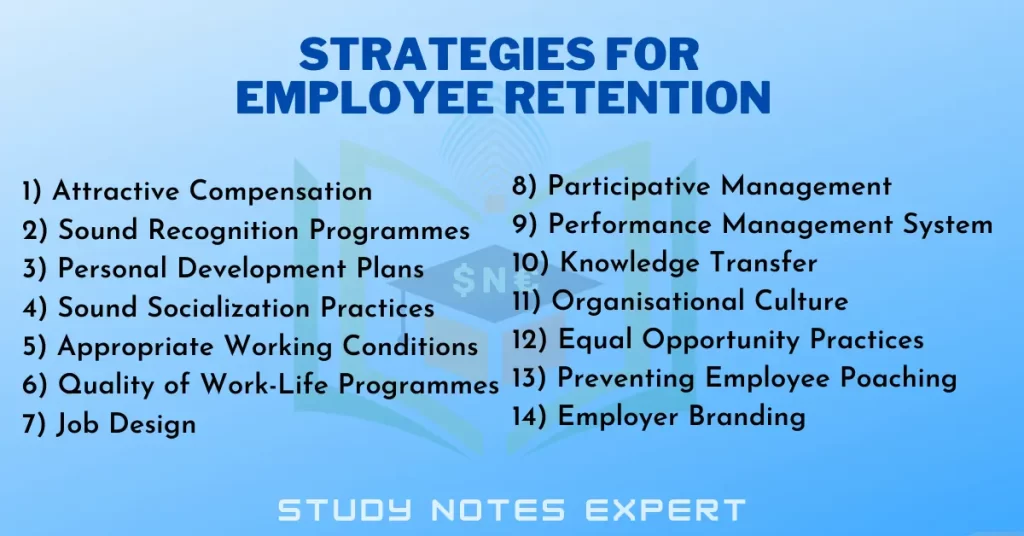Retention strategies are essential for every organization. These strategies are different from organization to organization. If any organization has good retention strategies, you can see the difference in work output between retained and newly hired employees. In this article, we will discuss the best strategies for employee retention.
New 14 Strategies for Employee Retention: You Should Know
Retention strategies are designed to create a good fit between employee’s preferences and their work situations. The strategy or best practices for retaining employees are as follows:

1) Attractive Compensation
Total compensation refers to the complete pay package awarded to employees on an annual basis, including all forms of money, fringe benefits, services, and in-kind payments. Organizations should carry out periodic compensation surveys and benchmark their compensation policies, systems, and practices with best practices. It must be increasingly tied with the organization’s strategic imperatives to drive forward its goals and objectives, both efficiently and effectively. Organizations should ensure that their compensation policies and practices help retain and motivate employees for higher performance and contribution to organizational goals and objectives.
2) Sound Recognition Programmes
It is well-accepted that money as a motivator has a boundary line. Therefore, a recognition system plays an increasingly pivotal role in retaining employees. Organizations should establish and administer various recognition programs encompassing employees’ professional, personal, and social activities, such as the employee of the Month award, Best Employee of the Year award, Best Sportsman, Star Performer Award, Star Team Award, CEO Award, etc. Recognition of personal and team achievements helps boost the morale and motivation of employees and enhances their commitment to their jobs and organizations.
3) Personal Development Plans
Individual investment in terms of training, education, and development of employees results in value addition to the employee’s skills and competencies. It improves his performance, confidence, and commitment towards organizational goals and objectives. It is one of the best and most straightforward strategies for employee retention.
It also helps in improving the career prospects of the employees in the organization, and they are able to visualize their future in the organization. This facilitates employee retention.
4) Sound Socialization Practices
These practices help in integrating newcomers into the organization. A good socialization experience provides crucial organizational information, job demands, performance expectations, relationship building, and high personal motivation. Socialization ensures a tight fit between the employee’s goals and aspirations and organizational culture and values. Effective socialization helps in the acclimatization of new employees on a long-term basis.
5) Appropriate Working Conditions
Since employees spend around 80 percent of their waking life in the workplace, working conditions profoundly influence employee retention. Organizations with appropriate health, safety, and welfare provisions are more likely to retain employees than organizations with poor health, safety, and welfare measures. Additionally, employee assistance programs and prevailing social conditions at the workplace affect employee satisfaction and, ultimately, turnover intention.
6) Quality of Work-Life Programmes
With globalization, the competitive pressures of business have affected job holders in a significant way. Employees are now increasingly required to put in long hours of work, which has enhanced stress and tension. Many families today have dual-income individuals and increasing job-related stress. Therefore, the quality of work-life programs influences employee retention. Organizations should offer facilities like maternity benefits and childcare, personal and professional counseling, flexible work, stress-coping programs, etc.
7) Job Design
Organizations should make jobs more empowering, challenging, and interesting to enhance individual learning, performance, and job satisfaction. Such measures result in improved employee productivity and contribution to the organization. Job design can be the smoothest strategy for employee retention.
8) Participative Management
Participative programs help in employee retention by involving employees in decisions that affect them. It also gives employees a sense of ownership, self-worth, and satisfaction. This requires the organization to improve open and interactive communication between and across various levels of the organization.
9) Performance Management System
Performance management helps employees set their work priorities and targets in tandem with their managers and seek meaningful feedback from their managers regularly to improve performance. Employees, being an integral part of the system, are more committed to the organizational goals and objectives.
10) Knowledge Transfer
Knowledge sharing is crucial for developing employees through work. Organizations that are characterized by a free flow of knowledge across the different levels of the organization are more likely to retain their employees. Knowledge sharing can occur through formal training and development programs and e-learning tools. Continuous training and education of employees are essential for bringing about continuous improvement in employees’ skills and knowledge.
11) Organisational Culture
Organizational culture and commitment depend on how individual perceptions and feelings hold together. This kind of strategy for employee retention is simple and easy to execute for every employee. It is difficult to say what decisively makes up a particular organization’s culture. However, commitment-oriented culture keeps motivated, satisfied, and productive.
12) Equal Opportunity Practices
Organizations with transparent, fair, and non-discriminatory practices are more effective in retaining their employees. Many times, talented employees leave their organization for want of perceived fairness. Compensation, rewards, and recognition programs are three key elements of equal opportunity practices.
13) Preventing Employee Poaching
With employees assuming center stage in the competitive advantage of organizations, especially in service sectors, headhunting by competitors and recruitment agencies is rampant.
Organizations must initiate effective measures for securing their present and potential employees by keeping internal e-mail addresses confidential, training telephone operators to spot calls from agents and to avoid giving them useful information, refusing to do business with agents who have poached employees in the past, and enter into an understanding with other organizations not to poach each other’s employees.
14) Employer Branding
It influences employee recruitment as well as employee retention as it acts as a lever for attracting the best employees and keeping satisfied employees with lower attrition rates. Therefore, in order to retain employees, organizations need to ensure that there is no gap between what the organization is saying in the outside world and what people believe inside the business. Aligning employer brands with employee value will likely contribute to employee satisfaction and positively affect employee retention.
(FAQ) Key Questions Covered in this Article:
- What are the 5 main drivers of employee retention?
- What is the need of employee retention strategy?
- Is employee retention beneficial for the organization or not?

